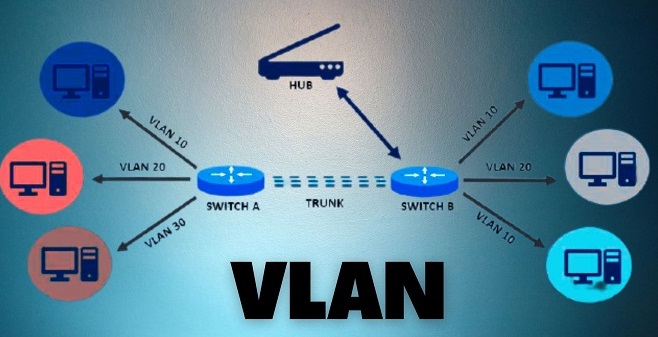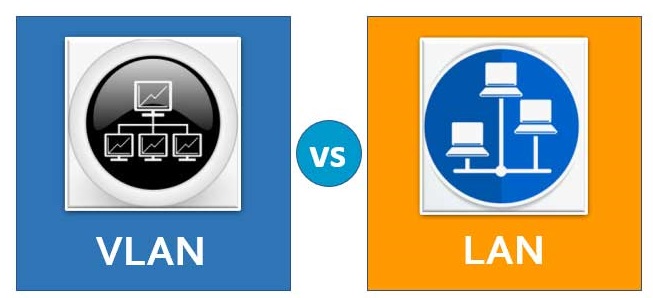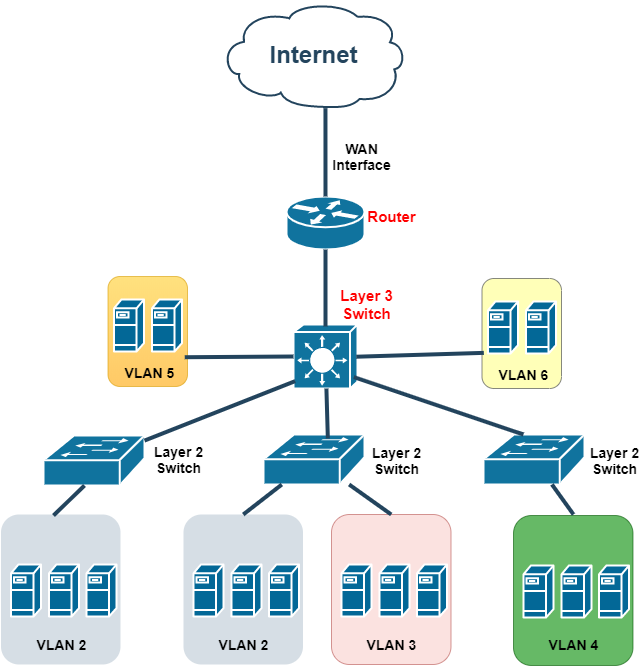VLAN Latest 2022
What is VLAN ?
VLAN (virtual LAN) is a logical overlay network that groups together a subset of devices that share a physical LAN, isolating the traffic for each group. A LAN is a group of computers or other devices in the same place — e.g., the same building or campus — that share the same physical network.
VLAN is a custom network which is created from one or more local area networks. It enables a group of devices available in multiple networks to be combined into one logical network. The result becomes a virtual LAN that is administered like a physical LAN. The full form of VLAN is defined as Virtual Local Area Network.

How VLAN is created?
You can create a VLAN using most switches simply by logging into the switch via Telnet and entering the parameters for the VLAN (name, domain and port assignments). After you have created the VLAN, any network segments connected to the assigned ports will become part of that VLAN.
What TCP IP layer is VLAN?
A VLAN (Virtual Local Area Network) is a fundamental concept in TCP/IP computer networks and every professional in this field must have a deep understanding of this technology. In networking, VLANs are implemented and configured on Ethernet Switches and they work at OSI Layer 2.
Does VLAN need IP address?
As each VLAN is a different network, they need their own address subnet (IPv4 and IPv6). The Campus Core switch will route between each VLAN (so called L3-switch: an ethernet switch which has some L3 routing capability). These IP addresses are also documented in the master IP address plan.
What is the difference between a LAN and a VLAN?

LAN stands for Local Area Network is a group of network devices which allow the communication between connected devices. On the other hand VLAN stands for Virtual Local Area Network which is used to enhance the performance of LANs (Local Area Networks).
What is the advantage of VLAN?
VLANs provide a number of advantages, such as ease of administration, confinement of broadcast domains, reduced broadcast traffic, and enforcement of security policies. VLANs provide the following advantages: VLANs enable logical grouping of end-stations that are physically dispersed on a network.
What is L2 and L3 VLAN?
Layer 2 VLAN is a single broadcast domain. It works on layer 2 (Datalink Layer). They can communicate only within it. And L3 VLAN is an Interface, that works on Network Layer. In order to do inter VLAN routing/ communication we need L3 interface (SVI).
What is the difference between VLAN and VPN?
VPNs provide authorized users and employees with secure connections to their organizations’ networks, while VLANs group geographically separate devices together to improve communication among the devices and simplify how network administrators make changes to network infrastructure.
Can you have 2 VLANs on the same port?
Since the purpose of VLAN tagging is to allow multiple VLANs on the same port, any port that has only one VLAN assigned to it can be configured as “Untagged” (the default) if the authorized inbound traffic for that port arrives untagged. A port can be a member of one untagged, port-based VLAN.
Can a switch be on a VLAN?
Adding virtual LAN (VLAN) support to a Layer2 switch offers some of the benefits of both bridging and routing. Like a bridge, a VLAN switch forwards traffic based on the Layer2 header, which is fast.
What are three primary benefits of using VLANs?
What are three primary benefits of using VLANs? (Choose three.) Explanation: Security, cost reduction, and improved IT staff efficiency are all benefits of using VLANs, along with higher performance, broadcast storm mitigation, and simpler project and application management
What is Layer 3 forwarding?
In a typical, centralized Layer 3 forwarding model, a Layer 3 router (virtual and physical) receives packets from a Cisco Nexus 1000V and forwards the traffic across the segments. In this model, the Layer 3 router can become a point of congestion or blockage for the flow of traffic.

Which are types of switch ports?
Switch ports can be classified in following types based on network architecture :
Access Port :
Trunk Port :
Hybrid Port :
Combo Port :
Stack Port :
PoE (Power over Ethernet) Port :
RJ45 Port :
SFP Port :
Can VLANs talk to each other?
In a nutshell, VLANs allow a group of Ethernet devices (subnet) to be physically separated by many Ethernet switches but communicate as if they were all connected to the same physical Ethernet switch.
Can we configure VLAN on router?
You can configure the software to allow traffic on a VLAN to be treated as if the VLAN were a router port. A port can be either a VLAN port or a router port, but not both. However, a VLAN port may be part of a VLAN that is itself a router port.
What is Layer 2 and Layer 3 network?
A Layer 2 switch only works with MAC addresses and doesn’t interact with any higher layer addresses, like an IP. A Layer 3 switch, on the other hand, can also do static routing and dynamic routing, which includes IP and virtual local area network (VLAN) communications.
What is Layer 2 and Layer 3 switch?
The layer 2 and Layer 3 differs mainly in the routing function. A Layer 2 switch works with MAC addresses only and does not care about IP address or any items of higher layers. Layer 3 switch, or multilayer switch, can do all the job of a layer 2 switch and additional static routing and dynamic routing as well.
Read More About ISO 27001
Buy From Amazon

2 Comments